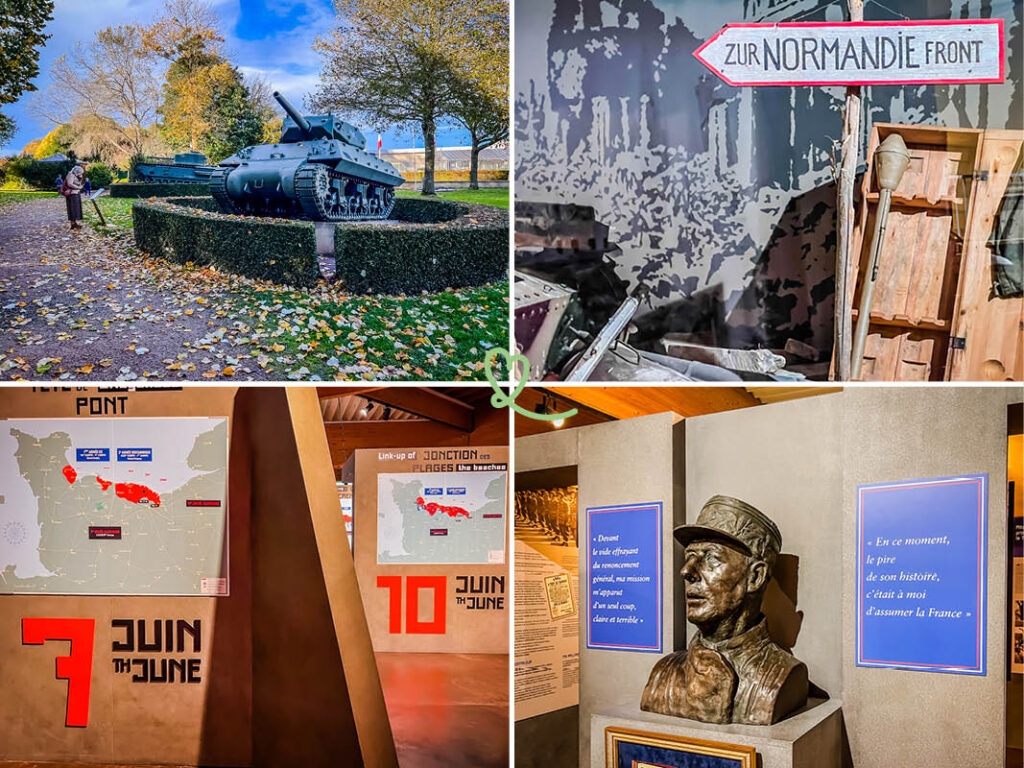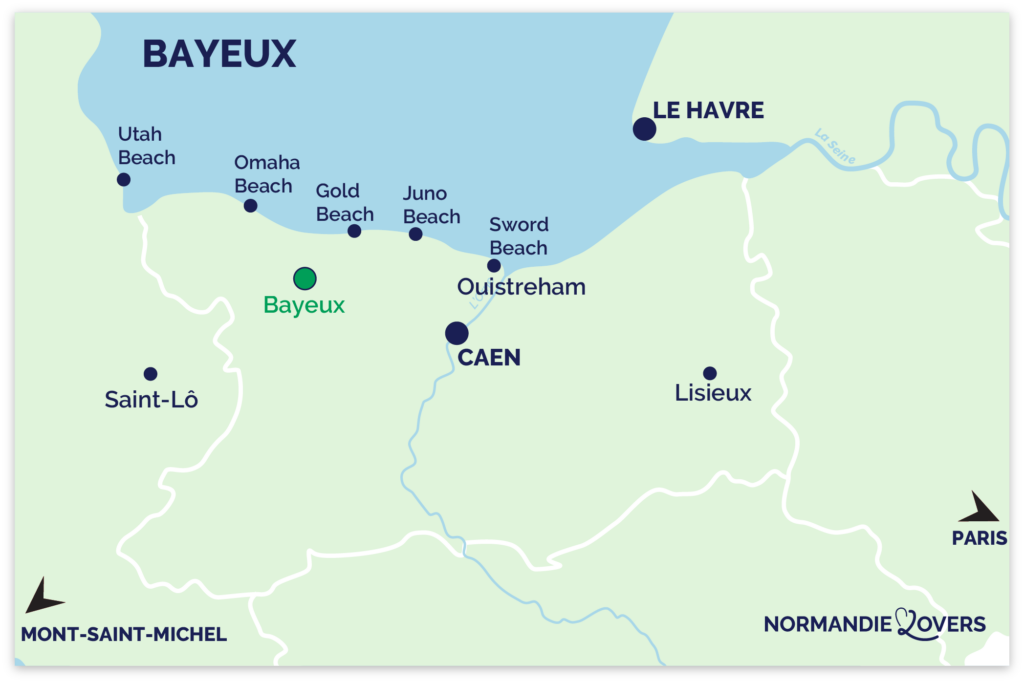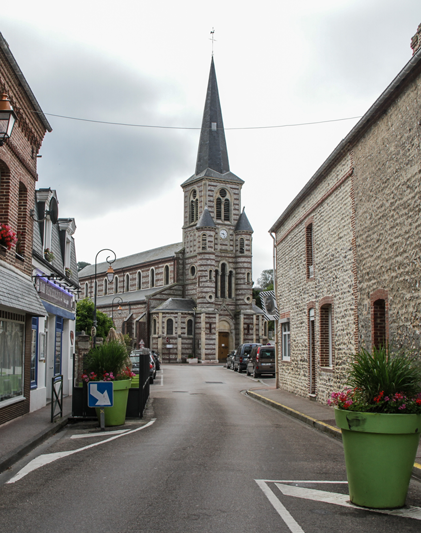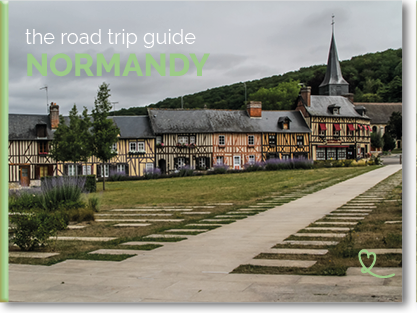Bayeux, capital of the Bessin region in Normandy and an ancient medieval city at the gateway to the D-Day landing beaches, is known for its famous Tapestry, its cathedral, its historic center and its museums.
Did you know that it was also the first city to be liberated in mainland France during the 1944 D-Day landings? If you are visiting Bayeux and you like History with a capital H, you can’t miss the Battle of Normandy Memorial Museum!
Unique in its kind, it retraces all the stages of the D-Day landings and of this legendary battle which contributed to put an end to the Second World War.
In this article, discover our opinion and our immersive experience in pictures to prepare your visit.

This review is completely independent, we visited anonymously and paid our admission in full.
Why visit the Battle of Normandy Memorial Museum in Bayeux?
Is the Battle of Normandy Museum worth a visit? Our review
Yes, this museum is well worth a visit. If you are passionate about D-Day and World War II history, the Battle of Normandy Memorial Museum in Bayeux will be on your list. We mentioned it in our 12 ideas of things to do if you are in the city.
Nearly 2300 m2 are dedicated to the exhibition of the military operations that marked the Battle of Normandy during the landing of the Allied troops in the summer of 1944.

Why is the Battle of Normandy Memorial Museum (Bayeux) famous?
The only museum that tells the story of the military operations of the summer of 1944 in detail, it is also quite close by car to the D-Day landing beaches.
Thanks to its chronological tour, you will be able to “go back in time” at the Battle of Normandy Memorial Museum with:
- illustrated stages and explanatory maps on the Landing from the beginning of June to the end of August 1944,
- displays featuring Allied and German soldiers and their equipment,
- the broadcasting of the archive film “Normandy 44, Decisive Victory in the West”.

Our favorite moments
You will find the details of our visit a little further on in this article. But we couldn’t help but share with you right now what we liked best about the Battle of Normandy Memorial Museum in Bayeux:
- the representation of the evolution of the conflict in the form of geographical maps to locate us in both space and time,
- the settings with many details on the daily life of the soldiers but also their equipment, their uniforms and their combat conditions,
- the life-size reconstruction of one of the most famous episodes of the Battle of Normandy: the Falaise-Chambois pocket in August 1944, a decisive moment when the Allied troops succeeded in surrounding the German soldiers.

A little history
Built in 1981, the museum is located in the heart of what is called the “pole of memory” of Bayeux, near the British Military Cemetery and the War Reporters Memorial.
It was voluntarily inaugurated in this city because Bayeux was one of the strategic places of the D-Day Landings and the Battle of Normandy. It was the first city in mainland France to be liberated from the German army on June 7, 1944.

Subscribe to our Newsletter
- Get away from it all with Region Lovers’ beautiful destinations!
- Once a month
- Advertising-free
Useful tips: Battle of Normandy Memorial Museum, Bayeux, France
Where is the Battle of Normandy Memorial Museum?
The Battle of Normandy Memorial Museum is located on Boulevard Fabian Ware in Bayeux (14400) in Normandy.

- Driving time from Le Havre: 1h30min.
- Driving time from Deauville: 1h05min.
- Driving time from Caen: 35min.
- Time from Cabourg: 50min.
- Driving time from Mont-Saint-Michel: 1h30min.
- Driving time from Ouistreham: 35min.
OUR ADVICE FOR RENTING A CAR IN Normandy
- Compare prices on our preferred platform: DiscoverCars – one of the best rated sites.
- Choose a car that is comfortable enough (distances can be long) but compact (some parking lots and villages are narrow).
- Think of thecomplete insurance (some roads are tortuous and narrow).
- There is a lot of demand, book it early.

How to get there
The ideal is to first go to Bayeux. The easiest way to get there is by car, but the city has a train station with regular trips every day.
See available timetables and book your train and coach tickets now.
The Battle of Normandy Memorial Museum is located in the southwestern part of the city of Bayeux, a 15-minute walk from the train station. This museum is part of the “memory pole” of the city only:
- 3min walk to Bayeux British Military Cemetery,
- 2min walk to the War Reporters Memorial in the city.

Once in the city center, we recommend you to go on foot (less than 15 minutes from the Old Bayeux) or to take the little tourist train to discover the different districts of Bayeux.
Parking
A parking lot is located right next to the Battle of Normandy Memorial Museum in Bayeux if you wish to park your vehicle there.

Schedules and rates
Schedules:
- February to April: from 10am to 12:30pm and from 2pm to 6pm.
- May to September: 9:30 am to 6:30 pm.
- October to December: 10am to 12:30pm and 2pm to 6pm.
The museum is closed on the afternoon of December 24 and 31, on December 25, and from January 1 to 31 inclusive. Open from February 1st to December 31st.
The last entrance to the museum is 45 minutes before closing time. And tickets are only available on site.

Rates:
- Full price: 7,50
- Reduced rate: 5,50€.
- School/student rate: 5€.
- Free for children under 10 years old.
Details of opening times and prices (2-museum pass and 3-museum pass, groups) are available on the official museum website.
USE OUR GUIDE TO PLAN A
DREAM TRIP TO Normandy
All the information you need for your trip:
- 8 maps that make planning easier
- 160+ pre-selected locations
- Practical advice
- 300+ photos to help you choose

Visit duration and practical information
Allow 1 to 1.5 hours maximum if you want to take the time to visit each stage of the museum.
This monument is accessible to people with reduced mobility.
Finally, the Battle of Normandy Museum is also part of the tour of the Little Tourist Train which allows you to discover the city’s heritage.

Best time to visit
In the morning or late afternoon, the museum is a little less crowded. The peak of affluence is generally recorded between 12 and 3 pm.
Like many tourist places in Normandy, July and August are the high season in Bayeux. However, with more than 500,000 tourists each year, it should be noted that, whatever the period, there will always be more or less visitors, even in “low season”. On the other hand, usually from April to June and from September to October, monuments and points of interest are less crowded.

Tips for visiting
We followed the direction of the visit proposed in the museum inside and finished the tour with the floats exposed outside in the garden. As it is a chronological tour, it is best to follow each step to (re)discover or remember the highlights of the famous Battle of Normandy in the summer of 1944.
The Battle of Normandy Memorial Museum with children
With your children, in a stroller, in a baby carrier or on foot, the visit is adapted. Depending on their age, they will also appreciate the reenactments, the displays featuring soldiers and the tanks exhibited in this museum.
WHERE TO STAY IN Bayeux
Option 1: Central and close to downtown
Within 5 to 10 minutes’ walk of the historic center, you’ll find beautiful mansions transformed into welcoming hotels and B&Bs. We recommend..:
- Hotel Domaine de Bayeux installed in an 18th century mansion – see prices, photos and availability.
- Hôtel le Lion d’Or in a former 18th-century post office building – see prices, photos, availability.

Option 2: in the countryside
The Normandy countryside is very green and inspiring. At the bend in the forest or in the fields, pretty villages with beautiful buildings transport you to another world, or even another era.
- Hotel Domaine de la Rançonnière, only 20 minutes from Bayeux – see prices, photos and availability.

Option 3: By the sea
The seaside is just 15 minutes drive from Bayeux. Breathe the sea air while enjoying easy access to Bayeux and the D-Day beaches.
- Hotel Villas d’Arromanches – see prices, photos and availability.

Nearby restaurants
The offer of restaurants in Bayeux is dense and of good quality. There is something for every taste and style! Here is our small selection:
- Restaurant l’Acte 2 – traditional and authentic Norman cuisine.
- Our experience at the restaurant L’Alchimie – fusion of local and foreign flavors.
- Our experience at the restaurant L’Alcôve – gastronomic meal in a friendly atmosphere.
- Restaurant Le Moulin de la Galette – fresh and local products in an establishment in the heart of historic Bayeux.
- Restaurant La Rapière – refined seasonal cuisine in a 16th century setting.
- Our experience at the canteen tea room Les volets roses – for a greedy and generous snack.
- Our experience at the restaurant La Maison B – generous family cuisine in a friendly atmosphere and a 1950’s style decor.
Subscribe to our Newsletter
- Get away from it all with Region Lovers’ beautiful destinations!
- Once a month
- Advertising-free
Beginning of the chronological journey after D-Day
Allied troops and Operation Overlord
As soon as you enter the museum, you will see the figures that have marked history and the world. On June 6, 1944, the Allied troops launched their great offensive, Operation Overlord, to allow soldiers to land on the Normandy coast. Old photographs of American and British generals are displayed at the beginning of the tour. And in particular of the staff at the origin of this brilliant operation!

By land, air and sea, nearly 3 million American, British, Canadian, Polish and French soldiers were deployed on the beaches of Normandy on the night of June 6, 1944.

Thanks to the numerous maps, you will be able to follow the stages of Operation Overlord and the Battle of Normandy throughout your visit to the museum. We particularly appreciated the explanations concerning the choice of the Normandy coast by the Allied troops to land.

Indeed, Normandy was relatively isolated from the rest of France at that time and its 5 main beaches, renamed Omaha Beach, Sword Beach, Utah Beach, Gold Beach and Juno Beach, were weakly fortified. An ideal and discreet place to launch operations.
Liberation of Bayeux
The city of Bayeux was liberated on June 7, 1944, the day after the D-Day landings. The museum tour is organized with several chronological panels to help you see the evolution of the conquest of the Normandy beaches by the Allied troops.

Bayeux thus became a strategic city for the Allies. Apart from the artificial harbors and bridges they built, the Allied troops built the first ring road at Bayeux. Nicknamed the By-Pass, this circuit was used to bypass the alleys of the medieval city to facilitate the supply and transport of soldiers and equipment to the front.

A meticulous military organization
To carry out this sensitive operation, a real turning point in the history of the Second World War, the Allied soldiers were well equipped. Portable transmitter, machine gun, anti-tank weapon and projectiles, gas mask, backpack, medical kit…

These weapons and objects have been reconstructed and are displayed further on in the museum. Get ready to see authentic British Army uniforms!
Heading for Caen and Cherbourg
In Caen, the former “capital” of Normandy, the city center was completely destroyed by bombing, to prevent any communication to the German reinforcements. The city was also a strategic issue for both the Allies and the Germans. It was only after 6 weeks of fighting that Caen was finally liberated by Canadian soldiers.

It was the American army that set sail for the northern part of the Cotentin Peninsula. The Battle of Cherbourg began on the first day of the D-Day invasion and ended on July 1, 1944 with the capture of the port of Cherbourg by American troops. A chaotic spectacle that the soldiers were confronted with because the quays, medians, sheds and railroads of the port were completely demolished.

At almost every step of your journey, you will have the opportunity to discover reconstructions of soldiers’ equipment, tanks and military weapons. Below is the American 40mm Bofors anti-aircraft gun which was used on small armored vehicles or light vehicles of the German army.

Each reconstruction is accompanied by explanations on a dedicated panel, sometimes with a photograph of the time. An experience of memory but above all of immersion!
DISCOVER Bayeux
- Best things to do in Bayeux
- Where to sleep in Bayeux: our best hotels
- Rent a car in Bayeux
- Where to eat in Bayeux: our best restaurants
- Visit the Bayeux Tapestry Museum
- Visit the Baron Gérard Museum of Art and History
- Visit the Battle of Normandy Museum
- Discover the Notre-Dame Cathedral in Bayeux
- Discover the British Military Cemetery
Behind the scenes of the Battle of Normandy
Allied engineering and clearing of ruins
This museum is also particularly interesting for its documentation on the “backstage” of the Battle of Normandy.

In addition to the physical reconstructions, numerous photographs from the period retrace the crucial moments of this significant battle.

Military engineering was already particularly developed after the First World War. Technological and military innovations have multiplied and thus transformed the tactics and strategies of war. You will witness this at the Battle of Normandy Memorial Museum. Take the time to admire the ingenuity and precision of the equipment of the time, on both sides.

The clearing of the ruins by the Allies began directly after the liberation of each town and village. Reconstruction is necessary to allow people to resume their lives. But it was also a way to revive maritime traffic and the rail network, which were essential to maintain the troops and continue the fighting.

Strategy and supply
The supply strategy was also a major issue for the Allied troops. Numerous educational and illustrated panels detail their strategy for supplying oil to the fighting troops.

Storing and transporting fuels also had to be secured and thought out in advance. A little further along the tour, a series of photographs shows the steps and vessels used by the Allied troops to get there.

It is thanks to this precise and meticulous organization that the Allies met with success, notably during one of the most famous episodes of the Battle of Normandy: the Falaise-Chambois pocket in August 1944. It was at this decisive moment that the Allied troops succeeded in surrounding the German soldiers. The life-size reconstruction left us speechless!

We really appreciated this total immersion and the attention to detail at every step of the museum tour. We really (re)immersed ourselves in this historical period until the victory in August 1944.

PLAN YOUR TRIP TO Normandy
Inspiration destinations
- Deciding where to go in Normandy – the best destinations
- Our weekend ideas: best-of, romantic, unusual, seaside, luxury, family
- 16 seaside hotels in Normandy
- The most beautiful charming hotels in Normandy

Best of

Practice
- Where to stay in Normandy – best places and hotels
- See our tips for renting a car at CDG airport, Orly airport, Beauvais airport, Caen, Rouen, Bayeux…

Journalists and reporters during the war
As you will see as you progress through the tour, a whole section of the tour pays tribute to war reporters. Reporting the major events of conflicts and documenting them on a daily basis is a remarkable job. In 1944, the population was only informed through the press and radio.

News agencies and radio stations sent numerous journalists, accredited by the Allied staff, to the field. A way to keep the population informed and to give news to the families of soldiers who have left for battle. This section is very visual, we really enjoyed contemplating all these pictures that testify of a great historical moment.

Do you know Lee Miller? American photographer and journalist, she was the only woman accredited as a war correspondent by the US Army in the early 1940s. You will find the scenography of all his journey illustrated in images and commented since his arrival on the Normandy coast in mid-June 1944.

If you want to know more about these journalists and war heroes, just a few minutes walk from the museum is the War Reporters Memorial. This memorial was erected by the City of Bayeux in collaboration with the association Reporters sans Frontières.

End of the visit: the Museum’s garden
After passing the explanatory panels on the psychological warfare waged by both sides, you will finally arrive at the museum garden. Here, several tanks, armored vehicles and military cannons of the time are exposed.

The City of Bayeux acquired some of these machines a few years ago to display them in its “memory center”. Only a few minutes walk from the Battle of Normandy Memorial Museum, you will find yourself at the British Military Cemetery, the largest in France.

OUR ADVICE FOR RENTING A CAR IN Normandy
- Compare prices on our preferred platform: DiscoverCars – one of the best rated sites.
- Choose a car that is comfortable enough (distances can be long) but compact (some parking lots and villages are narrow).
- Think of thecomplete insurance (some roads are tortuous and narrow).
- There is a lot of demand, book it early.

Frequently asked questions
Which memorial to visit in Normandy?
Known for its famous battle of the same name and the Allied landing on its shores in the summer of 1944, Normandy has many sites related to the history of the Second World War and honoring the soldiers killed at the front. Planning your trip according to this is not necessarily easy, so we have listed here the 25 D-Day sites to visit in Normandy. Beaches, museums, batteries, military cemeteries, memorials and commemorations… All you have to do is choose your route!
What is the most beautiful beach of the Landing?
Unavoidable if you visit Normandy, the 5 D-Day beaches have each their own history, their specificities and thus their charm. It’s hard to choose, so we have prepared a complete guide to visit the D-Day beaches in Normandy and immerse yourself in this turning point in history.



